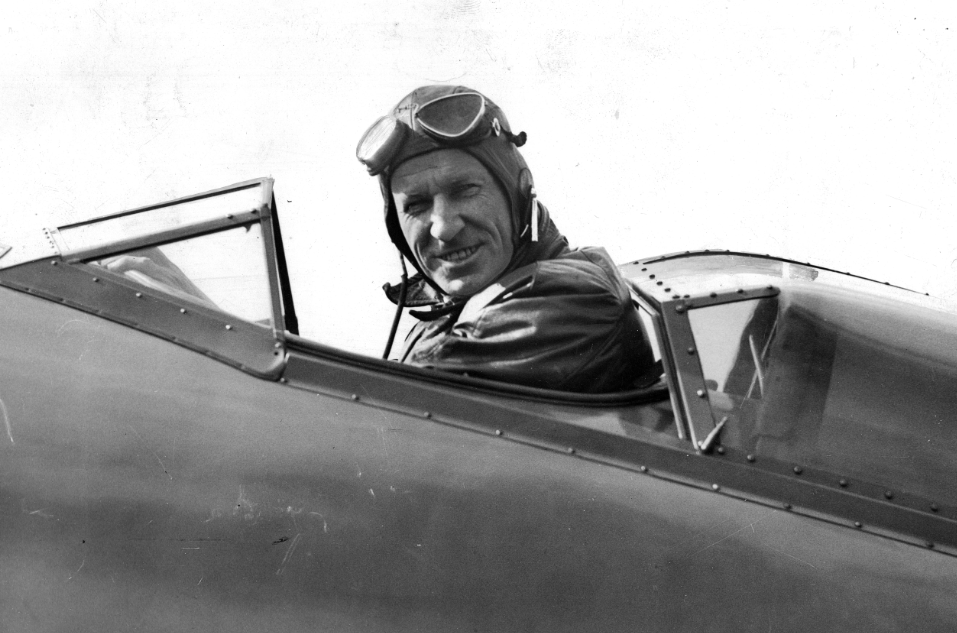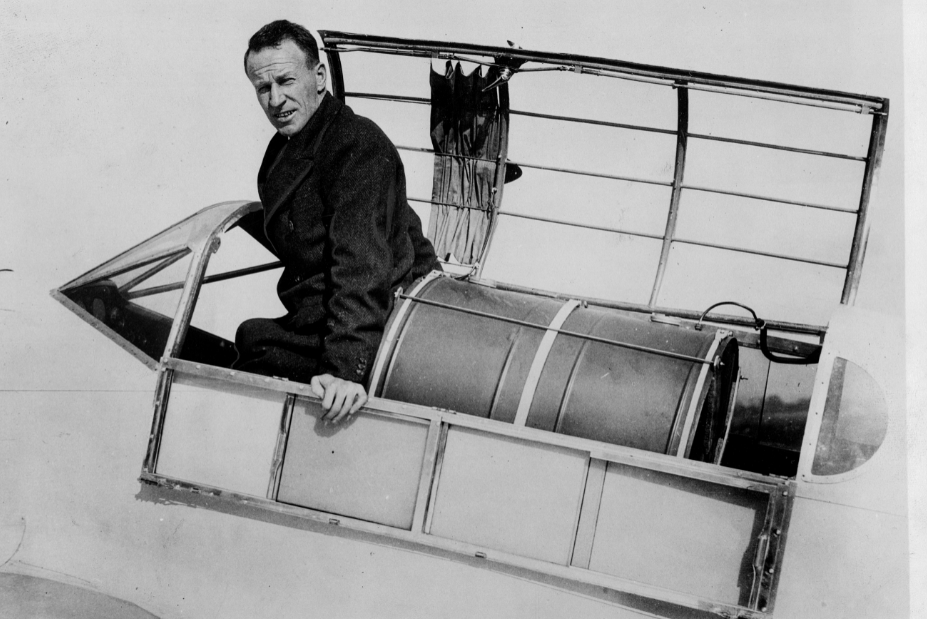Sir Charles Kingsford Smith was one of aviation’s greatest heroes; tirelessly piloting record breaking journeys, he pushed himself to the limits of what humanity was possible of in the aerial space and sealed his fate as a pioneer of modern flight.
Dubbed ‘Smithy,’ in both admiration and adoration by the Australian public, he earned international notoriety through his trans-Pacific flight from the United States to Australia, a voyage of over 11,585 miles. It was an astonishing achievement alone, made evermore notorious with the journey having claimed the lives of previous aviators. Due to this, Smithy earned his place within the Longines Honor Roll. He went on to set a number of impressive records throughout his career and is remembered today as an ‘international celebrity’, universally admired for his courage, skill and daring sense of adventure.[1]
Sir Charles Edward Kingsford Smith was born on the 9th of February, 1897 in Queensland, Australia. At just 13 he began his studies of mechanics and electrical engineering at the Sydney Technical College. At the onset of WWI, an adventurous and daring Kingsford Smith was desperate to sign up. At 18 he enlisted with the Australian Army (AIF) performing duties as a motorcycle dispatch rider before moving to the Royal Flying Corps.
He earned his wings in 1917 and wrote to his parents, ‘’I have discovered one thing about flying and that is that my future, for whatever it may be worth, is bound up with it.’[2]

Later, Smith was chosen to fly among the Britain’s Royal Flying Corps, a unit specialized in testing war crafts for the first time. For the beginning of The Great War, airplanes had been made of wood, fabric and wire, having been described as ‘breathtakingly basic.’[3]
Being so rudimentary, they were incredibly difficult and dangerous to operate, to the point where the Flying Corps was nicknamed as ‘the suicide club.’ [4] An apt nickname, for the RFC pilot’s average life was only 18 hours of flight and by 1917, the RFC was losing 12 aircraft and 20 crew daily.
Over half of the pilots died in training, and ‘new pilots lasted just 11 days from arrival on the front, to their death.’ [5] Lieutenant Cecil recalls:
‘You sat down to dinner faced by the empty chairs of men you had laughed with at lunch. The next day new men would laugh and joke from those chairs. And so it would go on.’[6]
Kingsford Smith was injured in active duty after being shot down in August, 1917. He severely injured his foot and was no longer able to serve the RFC as a pilot. He continued his duties as an instructor and was promoted to the rank of Captain. At just 20 years old he was awarded the Military cross for his heroism and bravery.
Kingsford Smith had fallen in love with aviation, moving to America at the end of the war to pursue his ambitions. He worked as a stunt pilot in Hollywood for a number of years before he witnessed the tragic death of a fellow colleague. This deterred Kingsford Smith from continuing as a stunt pilot and he moved back to Australia, setting his sights on grand adventures.
On return to Australia Kingsford Smith joined the newly formed West Australian Airways, delivering supplies and mail to remote areas. He flew the first regular air service between Geraldton and Derby.
In 1926, alongside C.T.P. Ulm, Kingsford Smith made a record breaking trip around Australia. The round trip was made in 10 days and 5 hours, beating previous pilots by some 10 days. On the back of this successful trip, Kingsford Smith and Ulm began to plan their astonishing adventure across the Pacific Ocean. Kingsford Smith purchased a Fokker VIIIb-3m from America and named her Southern Cross:

The Southern Cross weighed over 6000 kg. Its wingspan was 23 metres, it was about 15 metres long and just under 4 metres high. It had a cruising speed of just 93 miles per hour (about 150 kilometres per hour). In contrast, today’s commercial planes cruise at speeds between 500 and 950 kilometres per hour.[7]
On the 31st of May, 1928 Kingsford Smith left Oakland, California hoping to make the first trans-Pacific flight to Australia. The first leg would span California to Hawaii in 27 hours without error or mishap. The next stage brought the 4 man crew to Suva, Fiji, a distance of 3,000 miles. The Southern Cross battled against severe storms with Kingsford Smith at the controls until exhaustion forced Ulm to take over. They arrived in Fiji after a grueling 33 hours, battered and dead tiered.
From Suva, the final leg of the journey would take them onto Brisbane; a relatively short distance by comparison. They arrived on the 9th of June with a total flight distance of some 7,000 miles in 9 days. Smithy and his crew were greeted by an adoring crowd of over 25,000 people. A few days later this crowd was outmatched by the overwhelming reception in Sydney, where 300,000 people gathered to cheer them on. Smithy was an overnight sensation, adored by the public and respected by his fellow pilots.
Kingsford Smith went on to complete the first successful Tasman crossing to New Zealand, hoping to establish a regular mail route. An attempt had been made in January 1928 by the New Zealanders John Moncrieff and George Hood who had vanished without trace.

Alongside Charles Ulm, navigator Harold Arthur Litchfield, and radio operator Thomas H. McWilliams, the crew left Richmond on the 10th of September, 1928. A short yet treacherous journey of 1,600 miles they expected to land 14 hours later. They suffered through fierce storms and icy conditions before landing successfully near Cook Strait. The flight had taken them 14 hours and 25 minutes. New Zealand offered them a warm welcome with a crowd of 30,000 to greet the crew.
The return trip left from Blenheim, setting off on a journey that would see Smithy struggle through thick fog, horrendous weather and miscalculated navigation. The flight back to Richmond took over 23 hours, discovering upon touchdown that they had scraped through with only 10 minutes’ worth of fuel left in the tank.
Kingsford Smith went on to make an East-West crossing of the Atlantic from Ireland to Newfoundland in 31.5 hours. He received an incredible welcome in New York. From here he continued on to Oakland California, completing a circumnavigation of the globe that had begun in 1928. This would mark the second circumnavigation of the world by flight and the first within both Hemispheres. In 1930 he won an England to Australia air race in 13 days, landing in Sydney on the 22nd October 1930.
He was knighted in 1932 and appointed the honorary Air Commodore of the Royal Australian Air Force. In 1933, he flew the first commercial flight between Australia and New Zealand. In 1934 he flew from Australia to the United States in the first eastward crossing of the Pacific Ocean.

Sir Charles Kingsford Smith alongside his co-pilot Tommy Pethybridge disappeared over the Andaman Sea in November 1935.
Smithy was attempting to break the England to Australia speed record. His remains were never found. 18 months later the undercarriage leg and wheel of the Lady Southern Cross were washed ashore at Aye Island in the Gulf of Martaban.
The remains of this great aircraft, symbolic of Kingsford Smith’s epic legacy, are now on display at the Powerhouse Museum in Sydney, Australia.
Beloved by Australia and respected by fellow pilot’s, Smithy held more flying records than any other aviator during this time. Many believed him to be the world’s greatest pilot:
His contribution to civil aviation was an effort of faith and stamina and places him among the world’s notable pioneers. Lean, with ‘cool blue eyes’, generous mouth and terse manner, he is featured on the Australian $20 note. Sydney’s airport is named after him and there is a memorial to him, Taylor and Ulm at Anderson Park, Sydney.
The Southern Cross is on view at Brisbane airport. Kingsford Smith was the author of The Old Bus (1932) and, with Ulm, Story of ‘Southern Cross’ Trans-Pacific Flight (1928).[8]
His enduring fame and notoriety are a testament to the skill and tenacity that he demonstrated throughout every flight, every record broken, and every pioneering journey. His life and legacy are a testament to this Golden Age of aviation, to the courageous aviators who fulfilled humanity’s held desire to take to the skies.
Footnotes
- Australian Government, ‘Charles Kingsford Smith,’ Australian Stories, (australia.gov.au), http://www.australia.gov.au/about-australia/australian-story/charles-kingsford-smith (date accessed: 02/09/16).
- Australian Government, ‘Charles Kingsford Smith,’ Australian Stories, (australia.gov.au), http://www.australia.gov.au/about-australia/australian-story/charles-kingsford-smith (date accessed: 02/09/16).
- Jane Fryer, ‘Bravery of British WWI ‘suicide club’ whose fighter pilots took on Germany and the Red Baron with only 15 hours’ training and lasted on average just 11 days,’ The Daily Mail, (DMG Media, June 10 2010), http://www.dailymail.co.uk/news/article-1283972/Bravery-British-WWI-suicide-club-fighter-pilots-took-Germany-Red-Baron-15-hours-training-lasted-average-just-11-days.html (date accessed: 02/09/16).
- Jane Fryer, ‘Bravery of British WWI ‘suicide club’ whose fighter pilots took on Germany and the Red Baron with only 15 hours’ training and lasted on average just 11 days,’ The Daily Mail, (DMG Media, June 10 2010), http://www.dailymail.co.uk/news/article-1283972/Bravery-British-WWI-suicide-club-fighter-pilots-took-Germany-Red-Baron-15-hours-training-lasted-average-just-11-days.html (date accessed: 02/09/16).
- Jane Fryer, ‘Bravery of British WWI ‘suicide club’ whose fighter pilots took on Germany and the Red Baron with only 15 hours’ training and lasted on average just 11 days,’ The Daily Mail, (DMG Media, June 10 2010), http://www.dailymail.co.uk/news/article-1283972/Bravery-British-WWI-suicide-club-fighter-pilots-took-Germany-Red-Baron-15-hours-training-lasted-average-just-11-days.html (date accessed: 02/09/16).
- Jane Fryer, ‘Bravery of British WWI ‘suicide club’ whose fighter pilots took on Germany and the Red Baron with only 15 hours’ training and lasted on average just 11 days,’ The Daily Mail, (DMG Media, June 10 2010), http://www.dailymail.co.uk/news/article-1283972/Bravery-British-WWI-suicide-club-fighter-pilots-took-Germany-Red-Baron-15-hours-training-lasted-average-just-11-days.html (date accessed: 02/09/16).
- Australian Government, ‘Charles Kingsford Smith,’ Australian Stories, (australia.gov.au), http://www.australia.gov.au/about-australia/australian-story/charles-kingsford-smith (date accessed: 02/09/16).
- Frederick Howard, ‘Kingsford Smith,’ Sir Charles Edward (1897–1935),’’ Australian Dictionary of Biography, Volume 9, (MUP, 1983), https://adb.anu.edu.au/biography/kingsford-smith-sir-charles-edward-6964.
Bibliography
Anonymous, ‘Charles Kingsford Smith,’ Australian Stories, (australia.gov.au), http://www.australia.gov.au/about-australia/australian-story/charles-kingsford-smith
Fryer, Jane. ‘Bravery of British WWI ‘suicide club’ whose fighter pilots took on Germany and the Red Baron with only 15 hours’ training and lasted on average just 11 days,’ The Daily Mail, (DMG Media, June 10 2010), http://www.dailymail.co.uk/news/article-1283972/Bravery-British-WWI-suicide-club-fighter-pilots-took-Germany-Red-Baron-15-hours-training-lasted-average-just-11-days.html
Howard, Frederick. ‘Kingsford Smith,’ Sir Charles Edward (1897–1935),’’ Australian Dictionary of Biography, Volume 9, (MUP, 1983) http://adb.anu.edu.au/biography/kingsford-smith-sir-charles-edward-6964
